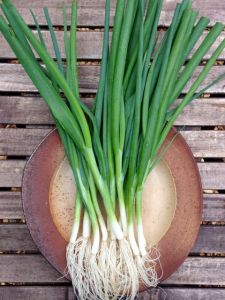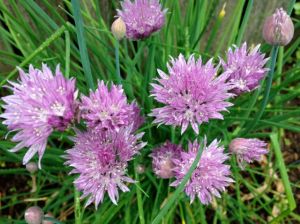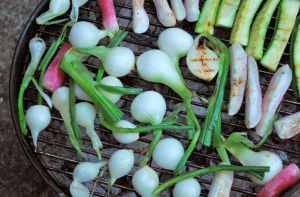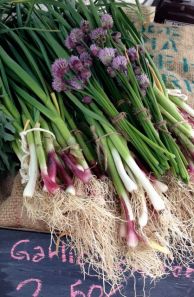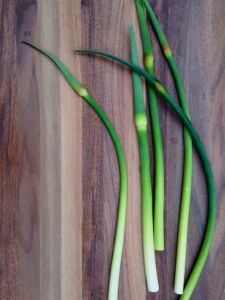The Fat Of The Land - Spring Alliums
Most cooks are familiar with the virtues of alliums, a botanical genus that includes garlic, onions, shallots and leeks. The alliums are a tribe of powerful flavors that constitute the backbone of countless soups, sautés, sauces, roasts, salads and stews. They are the definition of savory: pungently aromatic, acidic and spicy when fresh, oozing with deep, often sweet umami flavor when roasted. Their essence permeates a dish only to harmonize the other flavors, providing a song for them to dance to.
In the garden, as on the palate, alliums are lingering guests. Leeks, onions, garlic and shallots all have long maturation periods, occupying valuable garden real estate for up to nine months. Garlic, leeks, and shallots accomplish much of their extended growth period over winter, when little else is growing, but most onion varieties require spring planting and a long, luxurious soak in the sun to reach bulbing stage.
Late spring is the narrows of allium bulb availability: winter leeks are beginning to bolt, onion sets have just been planted, garlic and shallots are still a month or two from harvest, and storage bulbs are sprouting.
Luckily, lush, green spring has its own brand of alliums, enlisting fresh, herbal flavors, sweetness, and succulence in place of shelf-stable bulbs.
Scallions, also called green onions, bunching onions, or spring onions are one of two things: a variety of onion that never produces a bulb (usually labeled scallions or bunching onions) or a bulb-producing onion that has been picked before bulbing (usually labeled spring onions). The difference is horticultural, though not usually significant in the kitchen. True scallions (those that will never produce an onion) are one of the most nutritious alliums, boasting 140 times more phytonutrients than a typical white onion. Eaten fresh, they promise peak flavor and powerful nutrition in a small but versatile package.
Chives and their attractive purple flowers are one of the first edible alliums to appear in spring, sprouting as early as late February in our region. By May, their bloom is in full force, sending up a composite flower that is as attractive in a vase as it is delicious sprinkled on anything you can think of. Consider chives and their flowers as spring’s perfect condiment, adding a dash of oniony sweetness and densely packed nutrients to eggs, salads, pastas and more.
Salad onions, sometimes also called spring onions, are a variety of sweet, bulbing onion harvested before reaching maturity. Their juicy, tender bulbs and green tips are delicious raw or roasted. They are one of my favorite spring vegetables to grill: the bulbs caramelize into silky, smoky sweetness while the green tips get a little singed, adding a crispy, toasted onion accent.
Garlic Scallions are the garlicky cousin of scallions, immature garlic plants pulled while their bulb-ends are still tender and soft. Sliced thinly, they may be added raw to salads or used as a garnish. They are slightly drier than onion scallions, so roasting or sautéing them both deepens their garlic flavor and softens their texture. One of my favorite quiche preparations features garlic scallions; their combination of garlic-aroma and fresh allium brightness balances perfectly with the egg and cream richness.
Leek Scapes or shoots are the leafless flower stems of a leek plant. All alliums produce scapes—shallot and garlic scapes are seasonal delicacies that begin appearing in mid-June—which are an edible bi-product of a plant entering its next physiological stage. Unlike garlic or shallot scapes, leek scapes are best harvested by pulling out the whole plant once the flowering shoot has grown about four inches above the leaves (but has not yet bloomed). The blanched white stalk that leeks are best known for is still edible at this stage, and may be prepared by slicing it up to the point where it transitions to leaves. Peel back the leaves until you get to the firm but tender central stalk.
Later (a week or two from this point), the scape will become stiff like a young tree branch, but at this stage it should be slightly rubbery. The entire stalk and flower bud are edible and delicious, like leek-flavored asparagus. When my leek patch starts to bolt, I harvest them all at once, slicing the white bases and tossing them in the freezer to use later, extracting the scapes to cook now.
Sarah West is a gardener, eater and admirer of the agricultural arts. She gladly spends her Sundays as assistant manager of the Hillsdale Farmers’ Market, basking in the richness of its producers’ bounty and its community’s energy. Find archives and more at http://thefatofthelandblog.wordpress.com.
